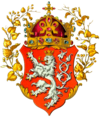Vratislaus II of Bohemia
This article needs additional citations for verification. (January 2008) |
| Vratislaus II | |
|---|---|
Conrad I of Bohemia | |
| Born | c. 1032 |
| Died | 14 January 1092 (aged c. 59–60) |
| Burial | |
| Spouse | Maria Adelaide of Hungary Świętosława of Poland |
| Issue |
|
Bretislaus I of Bohemia | |
| Mother | Judith of Schweinfurt |
Vratislaus II (or Wratislaus II) (
On his father's death in 1055, Vratislaus became duke of Olomouc, whereas his older brother became Duke of Bohemia as Spytihněv II. He fell out with his brother and was exiled to Hungary. Vratislaus regained the ducal throne of Olomouc with Hungarian assistance and eventually reconciled with his brother, then succeeded him as duke of Bohemia when he died in 1061.
Campaigns of Henry IV
Both Pope Alexander II and Pope Gregory VII confirmed Vratislaus in the privilege of wearing the mitre and tunic which his predecessors had.[4] Despite this, Vratislaus supported Henry in both the Investiture Controversy against the Popes and the rebellions in Saxony that dominated his long reign. These actions would negate the significance of the mitre.[4]
Vratislaus was often at odds with his brother Jaromír, Bishop of Prague. Jaromír, for his part, ignored the creation of a new Moravian diocese in Olomouc by Vratislaus in 1063.[5] Jaromir even went so far as to retake, by arms, the relics removed from Prague and taken to Moravia. Despite the pope's support for Vratislaus' new see, the Bohemian duke was unswayed in his loyalty to the emperor.
The Saxons revolted under Duke
Vratislaus also took part in the wars against the anti-kings who opposed Henry's rule and were elected by a faction of the nobility to replace him. At the Battle of Flarchheim, only through the aid of Vratislaus' contingent was the imperial army capable of overcoming the rebels of the papally-approved claimant Rudolf of Rheinfelden, Duke of Swabia.[6] Vratislaus even succeeded in seizing Rudolf's golden lance.[6] The golden lance was then carried in front of Vratislaus on state occasions.
Vratislaus would defeat the rebels again at Mailberg in 1082, and it would be in thanks for this victory that Henry granted Vratislaus the title of king in 1085.[7]
Relations with the papacy
Vratislaus requested permission to utilize Slavonic liturgy to the Roman Curia in 1080; the request was denied.[8] This petition may have been made in an effort to save a "Slavonic" Benedictine monastery still in operation that was founded in Sazava, close to Prague, in 1032.[8]
Vratislaus raised an army to serve in Henry's Italian campaign of 1081. In 1083, Vratislaus and his Bohemians were with Henry when they entered Rome itself.
Expansionism

Vratislaus coveted the largely Slavic marches of
Internal affairs
It was a
Sadly for Vratislaus, his last years were occupied by dynastic quarrelling. When his brother Otto died in 1086, he gave Olomouc to his son Boleslaus, which was seen to be an act against the interests of Conrad. Vratislaus raised an army against Conrad and sent it out under his other son
Vratislaus died of a hunting wound on 14 January 1092 after a reign of thirty years. He was buried in St. Peter and Paul's Church, Vyšehrad.[9]
Legacy
Vratislaus frequently found himself in conflict with
Family
Vratislaus was married three times. His first wife Maria died during premature
- Vratislaus (-1061)
- Casimir I of Poland
- Ludmila (-after 1100)
- Duke of Bohemia
In 1062, Vratislaus married a third time to
- Boleslaus (-1091)[12]
- Bořivoj II of Bohemia (c. 1064-February 2, 1124), Duke of Bohemia[12]
- Vladislaus I of Bohemia (-April 12, 1125), Duke of Bohemia[12]
- Soběslav I of Bohemia (-February 14, 1140), Duke of Bohemia[12]
- Judith (c. 1066-9 December 1108), married to Wiprecht II of Groitzsch
Notes
- ^ a b Krofta 1957, p. 426-427.
- ^ Lawler 2001, p. 173.
- ^ Krofta 1957, p. 426–427.
- ^ a b Berend, Urbanczyk & Wiszewski 2013, p. 384.
- ^ Berend, Urbanczyk & Wiszewski 2013, p. 375.
- ^ a b Thompson 1926, p. 621.
- ^ Wilson, Peter H. (2016). The Holy Roman Empire - A Thousand Years of Europe’s History. p. 207.
- ^ a b Berend, Urbanczyk & Wiszewski 2013, p. 316.
- ^ František Palacký: Dějiny národa českého v Čechách i v Moravě, book III
- ^ Ketrzynski 1950, p. 39.
- ^ Grudziński 1985, p. 201-202.
- ^ a b c d e Knoll & Schaer 2003, p. 82.
References
- Berend, Nora; Urbanczyk, Przemyslaw; Wiszewski, Przemyslaw (2013). Central Europe in the High Middle Ages: Bohemia, Hungary and Poland, c.900-c.1300. Cambridge University Press.
- Grudziński, Tadeusz (1985). Boleslaus the Bold, Called Also the Bountiful, and Bishop Stanislaus: The Story of a Conflict. Interpress Publishers.
- Ketrzynski, S. (1950). "The Introduction of Christianity and the Early Kings of Poland". In Reddaway, W.F.; Penson, J.H.; Halecki, O.; Dyboski, R. (eds.). The Cambridge History of Poland: From the Origins to Sobieski (to 1696). Cambridge University Press.
- Krofta, Kamil (1957). "Bohemia to the Extinction of the Premyslids". In Tanner, J.R.; Previte-Orton, C.W.; Brooke, Z.N. (eds.). Cambridge Medieval History: Victory of the Papacy. Vol. VI. Cambridge University Press.
- Knoll, Paul W.; Schaer, Frank, eds. (2003). Gesta principum Polonorum: The Deeds of the Princes of the Poles. Central European University Press.
- Lawler, Jennifer (2001). "Bohemia (chart 1)". Encyclopedia of Women in the Middle Ages. McFarland & Company Inc.
- Thompson, James Westfall (March 1926). "Medieval German Expansion in Bohemia". The Slavonic Review. 4 (12).
Literature
- ISBN 80-7021-655-7
- Hans Patze: Die Pegauer Annalen, die Königserhebung Wratislaws v. Böhmen und die Anfänge der Stadt Pegau. JGMODtl 12, 1963, 1-62
- Percy Ernst Schramm: Böhmen und das Regnum: Die Verleihung der Königswürde an die Herzöge von Böhmen (1085/86,1158,1198/1203) (Adel und Kirche. G. Tellenbach z. 65. Geb. Hrsg. J. Fleckenstein-K. Schmid, 1968), 346–364.

